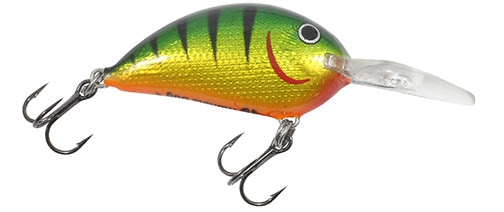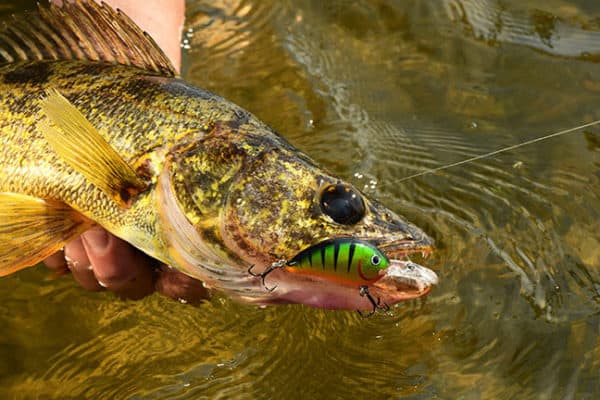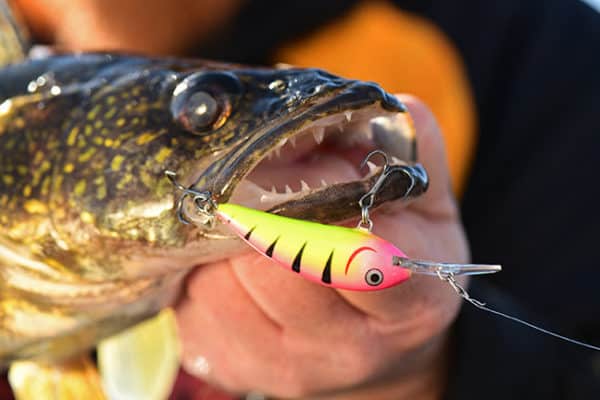Crankin’ for Early-Season River Walleyes
Category: article
Mar 30th, 2022 by Keith Worrall
Modified Mar 30th, 2022 at 2:29 PM


Crankin’ for Early-Season River Walleyes
Seasoned river rat gives a straightforward sermon on crankbait techniques.
BEMIDJI, Minn. (March 30, 2022) – In the spring, the lion’s share of anglers troll cranks on long line or lead core slowly up the river channel. Yet, there are group of current specialists Northland pro Brian “Bro” Brosdahl calls the “river rollers.”
“We run up and down the river hitting multiple areas run-and-gun bass style, but for walleyes—strategically pitching crankbaits and slow reeling – or rolling – through the contact zone. Cast up close to shore or structure with a Northland Rumble Shad, and rip it once about every two- to three-feet, reeling the handle slowly, rolling it through the fishy areas,” notes Brosdahl.
With river water temperatures in the 40s and 50s, walleyes are lethargic but still looking to feed. On most casts, the Rumble Shad lip will bounce off rocks and other structure, causing fish to react. This digging motion wakes up the walleyes. Look for areas such as wingdams, log piles, sandbar breaks, riprap, and current seams.

Rumble Shad (Perch)

Rumble Shad (Gold Perch)

Rumble Shad (Bubblegum Tiger)
Wingdams
Wingdams are a line of rocks piled from shore out 40- to a 100-feet to push current to the center of the river. They allow barges to carry cargo up and down a relatively shallow river. Wingdams not only break current, but hold walleyes on the front current side and sometimes on the tip. In front of a wingdam, as the water roars across, a current seam or slack-water forms. This is a great spot to slow roll a Rumble Shad or Rumble Bug. Position your boat 30- to 50-feet upriver from the wingdam. Ideally, you want to position in the center, which is better for casting and reaching both ends, as well as behind the boat. Trolling motors with a lock feature are ideal for wingdam fishing. Pitch up to the wingdam top and reel back. Also, casting down to the front side and banging the bottom and working on a slow curve back to the boat can produce.
It should be understood, though, that some wingdams hold more fish than others. Some lend better access to deep water or might be in the middle of a stretch of wingdams. Productive wingdams often have an irregular shape, such as a missing spot due to ice or boat traffic or damage to the rocks. These gaps will hold fish. This is your target point for casting. In terms of finding wingdams, most are marked on GPS maps. Many anglers will use side finding technology on a drive by to see if there are active fish or unique features, looking for one- to four-foot contours, which helps to find the target zone for pitching and rolling cranks.

Rumble Bug (Perch)

Rumble Bug (Gold Perch)

Rumble Bug (Bubblegum Tiger)
Logjams
High waters and floods are constantly eroding the river, and sometimes trees will pile up in river areas. Sometimes, one or several logs down on a riverbank will hold walleyes. The current often cuts a scour behind the logs. Many of the log piles Bro fishes will be in four- to six-feet of water, but have a 10- to 12-foot scour hole behind it.
Bro remarks, “Position your boat in front of the logs within a reasonable casting distance. Pitch your Rumble Shad or Rumble Bug past the logs and slow roll through. Walleyes will hit it as the bait is passing through the hole and sometimes right at the logs.”
Bro suggests using a heavier braid in the 12- to 16- pound class, which lets you retrieve lures from snags.
Sandbars
Walleyes will also hold on sandbar cuts; they break the current and are a good ambush spot for passing and schooling baitfish. Sandbars are most often located on the slack end of current seams and river bends. Sand is ideal for rolling a Rumble Shad or Rumble Bug and digging down the sides with less chance of snags, although one should always keep in mind that there could be brush or wood sticking out that is buried in the sand.

Riprap
Riprap rock is typically installed to prevent shoreline erosion. Rolling cranks along riprap is highly effective in the first ten feet of the cast. Most fish along these rocky areas are tight to shore, so Bro recommends positioning the boat within 20-feet of the shore and pitching at an angle up or down river to reel the Rumble Shad or Rumble Bug down the rocky steps holding fish.
Some riprap areas span hundreds of feet or yards. Most of the fish are in small, irregularly shaped areas, however, where the riprap forms a point or some other anomaly.
Current Seams
Current seams are created in a river downstream from neckdowns to wide spots. They can be found in river bends or anywhere something obstructs the current flow, too. You can see an actual line where the current speed changes from fast to slow and water speed and or direction fluctuates. Walleyes will hang in these areas to rest from fighting the current and to intercept forage. Current seams are common near shore and are great places to roll crankbaits.

Crankbaits and Rods
The ideal crankbaits for early-season river fishing are Northland Rumble Shad and Rumble Bug. Depending on water clarity, solid color choices are Perch, Gold Perch and Bubblegum Tiger. The Rumble Shad RSD7 (2-3/4 inch, ½ ounce) has a 12-foot dive curve, which is perfect for most situations and the RSD5 (2-1/2 inch, 3/8 ounce) is a finesse fishing option.
In terms of rods, Bro prefers pitching crankbaits on a St. Croix Victory Power Target Cranker VCT72MHM (medium-heavy power, moderate action casting) or Eyecon Crankin’ EYS70MM (medium power, moderate action spinning).
Parting Words
There’s little more satisfying than catching walleyes in open water after a long season on the ice. Our advice? Get your cranks organized, the boat ready to go, and hit the river! Take Bro’s words to heart and you’re likely to have the best early-season yet!